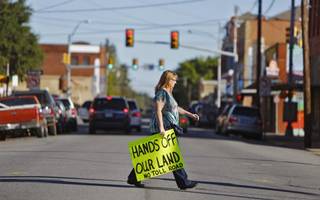Former Dallas City Manager Mary Suhm has a theory for why the long-running controversy surrounding the Trinity River toll road has flared up in recent weeks. Federal officials are poised to either clear or deny the project within months.
“We’re at a decision point,” she said Monday during a luncheon of the Stemmons Corridor Business Association.
Suhm was one of four project supporters who explained the road’s context, history and perceived need during the meeting. They were followed by two of the project’s most visible critics, who tried to sell association members on why the road is a bad idea.
But Monday’s lunch meeting was anything but a debate. There were no arguments, no formal counterpoints, no questions from the audience. Suhm, without delving deeply into details, even said some of the criticisms of the project have merit.
Still, a seed of what spurs much of the differing views on the Trinity Parkway was clearly visible, and it had everything to do with traffic. Or, more precisely, whether traffic planners’ ideas really cut congestion or simply induce it.
In his introductory comments, the business association’s chairman, Larry Bennett, said there’s little debate about the need for the road planned to run near Interstates 30 and 35E. He said it will alleviate traffic on some of the state’s most congested highways.
“If our employees and customers can’t easily get to us, we’re not going to be able to continue to grow,” he said.
North Central Texas Council of Governments Transportation Director Michael Morris said a number of road projects and expansions underway or about to begin were designed under the assumption that the Trinity toll road would eventually be built. The Trinity Parkway will connect to Interstate 45 southeast of downtown and to I-35E and State Highway 183 northwest of downtown. It will run inside the Trinity River levees for most of its 9 miles and could flood after extreme rainfall.
Morris said several bottlenecks will be created around downtown if highways outside of the urban core are expanded, but new capacity inside of it doesn’t keep pace.
“The keystone is the Trinity Parkway,” he said of billions of dollars’ worth of planned highway projects.
But project opponents said the road will be destructive to the city’s plans to turn the Trinity River corridor into a massive park with picturesque lakes and a number of recreation areas. Dallas City Council member Scott Griggs called the road a “monster” that has grown in scale since voters first approved it in 1998.
“We’re more than about building systems of roads,” he said. “We’re about building a city.”
Urban planner Patrick Kennedy, president of the North Texas chapter of the Congress for the New Urbanism, said creating more capacity will simply create more traffic. Kennedy also said that the solution is not cutting drive times to work by adding more roads, but getting more people and jobs toward the center of the city so homes and workplaces aren’t so spread out.
Little mention was made of the project’s financing, except for a few comments from Kennedy. The city faces a shortfall of more than $1 billion in building the $1.5 billion project. Its partner in the project, the North Texas Tollway Authority, isn’t expected to complete a full feasibility study until after federal officials clear it for construction.
Morris’ agency next month will ask its transportation council for the OK to lobby state lawmakers to clear the way for the Texas Department of Transportation to help find private investors to fill in the shortfall. Texas Transportation Commission member Victor Vandergiff, though, said he doesn’t want TxDOT involved when NTTA can already find investors.
Kennedy said toll projects across the country — including State Highway 130 near Austin — have faced financial problems after expected revenues never materialized. He said tolls can help control congestion on existing highways, but questioned using them primarily as a way to finance a new road.
“You usually have a problem receiving that revenue,” he said.
Follow Brandon Formby on Twitter at @brandonformby.









To post a comment, log into your chosen social network and then add your comment below. Your comments are subject to our Terms of Service and the privacy policy and terms of service of your social network. If you do not want to comment with a social network, please consider writing a letter to the editor.